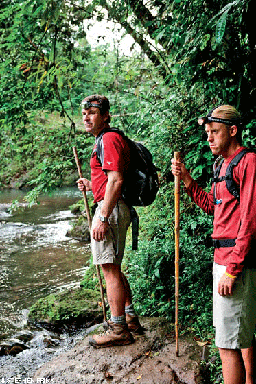Two American college students in their 20s were backpacking in the Bolivian Andes. They were experienced hikers but had not backpacked internationally before. Both travelers were in good health and exercised regularly. They were near the town of Cochabamba, southeast of Bolivia’s capital, La Paz.
The Incident
They ascended from an altitude of approximately 9,000 feet above sea level to 13,000 feet in the first 48 hours of their hike. The following morning, one of the young men began to experience disorientation and difficulty breathing. He had complained of a persistent headache, fatigue and slight nausea since arriving at the hike’s initial altitude, but the confusion and respiratory distress were new symptoms and very concerning to both backpackers. They descended to seek a medical evaluation at a local clinic.
The local doctor, who was very familiar with altitude-related illnesses, suspected acute mountain sickness (AMS). Upon examination, the physician detected fluid in the young man’s lungs (pulmonary edema). Additionally, the patient exhibited impaired coordination and concentration. The doctor was concerned these symptoms might indicate cerebral edema, or increased fluid around the brain. These clinical indicators not only confirmed the diagnosis of altitude illness, they suggested the most severe forms of it: high altitude pulmonary edema (HAPE) and high altitude cerebral edema (HACE). The doctor initiated treatment with oxygen and appropriate medications. The patient improved, but only slightly.
The Complication
Oxygen and other medications are important elements in the treatment of AMS and can delay worsening of the condition. The definitive treatment for altitude illness, however, is prompt evacuation to a lower elevation. Due to the seriousness of this patient’s symptoms, he would need a hospital capable of acute care. There were hospitals nearby that could provide the appropriate care, but they were no lower in altitude than the clinic. Both the patient and his traveling companion were DAN® Members, so they contacted DAN seeking assistance.

DAN medics obtained a thorough medical report from the treating doctor and quickly determined the patient needed to be evacuated. DAN’s consulting physicians along with DAN TravelAssist® and DAN’s Latin American regional liaison began searching for a facility capable of providing appropriate care and below an altitude of 5,000 feet. Facilities that met both criteria were not easily identified. The local doctor could continue care for another 24 hours but was concerned the patient’s condition would worsen despite the treatment he was receiving.
A satisfactory hospital willing to accept the patient was found in Santiago, Chile. Santiago, however, is approximately 1,150 miles from Cochabamba. The evacuation would require a jet with sufficient range to travel that distance without refueling. An air ambulance provider with a professional medical team and a suitable aircraft was identified and contacted.
The evacuation proved to be a logistical challenge: Among other complications, the air ambulance provider could not land the jet at the nearest airfield to Cochabamba because the runway was too short. They used a twin turboprop (propeller-driven plane) to fly the patient to a nearby airfield with an adequate runway for the jet to land and take off. From there, he was successfully transferred to the hospital in Santiago with no complications or deterioration of his condition. He remained hospitalized for the next week and made a complete recovery.
Discussion
Divers, in general, are well versed in dive-related injuries. Most also investigate tropical diseases when traveling to areas where that risk is present. There are other travel-related illnesses, injuries and complications, however, that are not as common or easily anticipated; AMS is one of those illnesses. Although most divers are familiar with the risks of flying or ascending to altitude after diving, an altitude exposure alone can be sufficient to cause illness, as this case illustrates.
The most common early symptom of AMS is a headache. If an individual remains at altitude, lethargy, malaise and more serious symptoms may follow. Some symptoms of AMS are also among the symptoms observed in cases of decompression sickness (DCS), which can complicate distinguishing DCS from AMS when people have dived and ascended to altitude around the same time. AMS is also like DCS in that it is highly probabilistic: There are identifiable risk factors, but occurrence is largely a matter of odds. Even a person’s previous experience is not always a reliable indicator of future susceptibility; an individual might be unaffected during some ascents to high altitude and incapacitated during others.
Traveling divers should not be discouraged from participating in excursions to higher altitudes and enjoying the beauty of these environments. However, they should consider the unique hazards and take appropriate precautions when exploring these regions.
Altitude Illness
Altitude illness is the result of decreased barometric pressure and decreased partial pressure of oxygen. Symptoms can manifest in three different ways:
AMS — Acute mountain sickness is the mildest and most common form of altitude illness. It is usually characterized by a headache, general malaise, loss of appetite and insomnia. Acclimatization over several days may be sufficient to preclude additional symptoms. A slow ascent rate, rest, light exercise, a high-carbohydrate diet and some medications may help with acclimatization. People with symptoms of AMS should be monitored for more severe symptoms.
HACE — The symptoms of high altitude cerebral edema indicate a brain in distress. They include disorientation, intense headache, impaired coordination, personality changes and other neurological symptoms.
HAPE — High altitude pulmonary edema is the most deadly form of altitude illness. Its onset is marked by shortness of breath, particularly at rest, and a cough. In later stages, the cough may become productive.
Administration of oxygen is appropriate first aid for altitude illness. Dangerous cases have been documented as low as 8,000 feet. Descent is critical if signs or symptoms of HACE or HAPE are observed.
© Alert Diver — Q3 Summer 2011